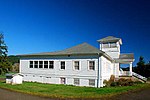Riley–Cutler House
1892 establishments in OregonHouses completed in 1892Houses in Polk County, OregonHouses on the National Register of Historic Places in OregonNational Register of Historic Places in Polk County, Oregon ... and 4 more
Oregon Registered Historic Place stubsQueen Anne architecture in OregonRelocated buildings and structures in OregonUse mdy dates from August 2023

The Riley–Cutler House is a historic residence located in Pedee, Oregon, United States. It was built in 1892 by David Riley, the owner of the local sash and planing mill in which the house's elaborate woodwork was made. In 1979, it relocated from to Pedee from Dallas, Oregon. The house was listed on the National Register of Historic Places in 1980.
Excerpt from the Wikipedia article Riley–Cutler House (License: CC BY-SA 3.0, Authors, Images).Riley–Cutler House
Pedee Creek Road,
Geographical coordinates (GPS) Address Nearby Places Show on map
Geographical coordinates (GPS)
| Latitude | Longitude |
|---|---|
| N 44.768396 ° | E -123.445507 ° |
Address
Pedee Creek Road 11514
97361
Oregon, United States
Open on Google Maps









